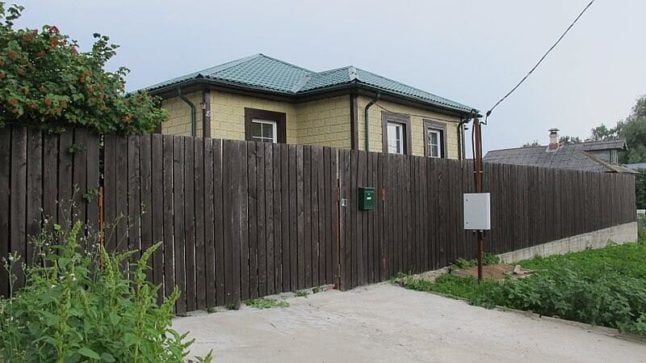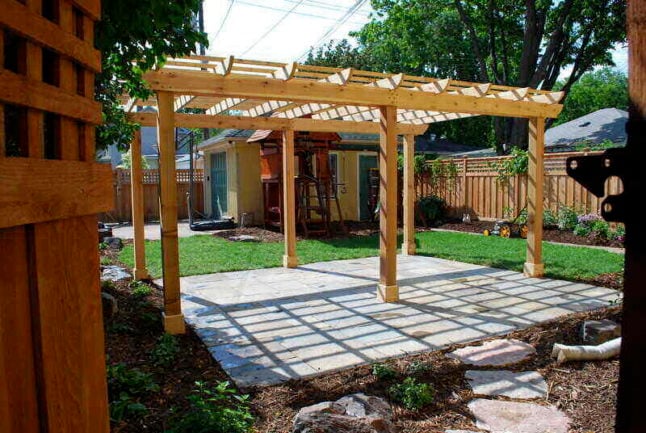
Your backyard should be a place of refuge, but ear-splitting highways or noisy neighbors will quickly turn that reality into a far-fetched dream. Luckily, you can combat these audible obstacles with landscape design. From creating a soundscape to growing suitable plants, we’ll show you the basics of how to landscape for noise reduction.
We’ll brief you on a few common tips and tricks to reduce sound pollution in your outdoor space–– no earplugs necessary.
Why landscape for noise reduction?
Human brains have evolved to pick up on noise as a method of defense. The Hearing Health Foundation notes that sudden sounds can trigger your body’s stress reaction. If the sound is unpleasant, your brain learns to involuntarily release cortisol in reaction to a sound over time.
Cortisol is the body’s primary stress hormone, so more of it is not ideal for your sense of well-being. Too much stress is related to many health issues like cardiovascular disease, poor sleep, and a decrease in your overall quality of life.
Outdoor noise is inescapable, but depending on where you live, noise can be more concentrated or direct. Think of anything from whirring air conditioners to a busy pool deck surrounding your backyard.
You could put on a pair of earplugs every time you step outside, but that would block out pleasant sounds, such as birds and babbling brooks. We’ll dive into different ways your landscaping reduces noise pollution and, therefore, the stress of unwanted sounds in the backyard.
How to reduce noise with landscaping
Fences

Fences are often lumped into aesthetic beauty in landscaping, but they serve many other purposes, such as security, privacy, and pest control.
The right fence will block out nuisance noises, too. In fact, some fences are specially designed for that purpose. Acoustic fences are a prime example of a fence style created to protect inhabitants from noise pollution.
But beyond acoustic fences, there are other standard options to consider. As a general rule of thumb, the thicker the fence, the better it is at blocking out sound. These fence options are excellent choices for reducing unwanted sound waves.
When choosing fencing materials, make sure they’re solid with no gaps or spaces to not only maximize your sense of privacy but also act as a solid sound barrier. Material options include:
- Solid red cedar
- Stone wall or masonry wall
- Concrete
- Stucco
- Composite
- Vinyl
Pergolas

These tasteful landscape features are standing structures typically made of wood or other composite materials. They look similar to the frame of a tent with an exposed roof and sides. Pergolas absorb some of the impacts of sound. Apply sound-absorbing tiles to your pergola for extra protection against noise pollution.
Pro Tip: Pergolas are commonly sold alongside fences and sometimes even customized to match your fence style.
Sound-reducing plants

Pxhere
Certain vines, trees, and shrubs have a natural dampening effect on noise due to their soft surface that absorbs sound waves. Whether it’s their height or the natural white noise leaves produce in the breeze, landscaping for noise reduction involves careful consideration of the vegetation you plant in your outdoor space.
Pro Tip: Plant various trees and shrubs to create a forested area. Thick vegetation that grows tall, is low maintenance, and is evergreen will be your best bet in eliminating noise. While not all evergreens are low maintenance, when treated properly, they maintain green foliage all year long–– even during periods of harsh weather.
Consider these tree species to help improve the noise problem in your space:
- American holly tree
- Arborvitae tree
- Spruce tree
- Pine tree
It’s not just trees that deaden unwanted noise. Plants with thick bark and bushy leaves will effectively reduce noise or spread the sound waves around, resulting in a quieter home. These are the best plants when it comes to lowering nuisance sounds from a busy street to a loud voice:
- Laurel (hedge)
- Boxwoods (hedge)
- Viburnum (flowering shrubs)
- Ivy (the vines grow on walls and offer an additional layer of sound-dampening)
Once you know what to plant, you’ll need to know the correct way to grow them. Some important planting tips to keep in mind are:
- Plant your trees close to the source of the noise
- Plant your trees and shrubs close together or in rows to double up on the thickness of the barrier
Note: If the noise is close to your home or other buildings, be mindful about planting trees and shrubs that grow very tall. The last thing you’d want is extreme weather knocking them over onto structures on your or your neighbor’s property.
Berms
As an alternative to a noise-reducing fence, berms are a reliable option that decrease unwanted sounds without installing hardscape features, like fences and pergolas. Simply put, a berm is an elevated, compacted-soil barrier. For homeowners trying to incorporate noise-canceling landscaping, building a berm along the length of where you’re attempting to block sound will limit the noise from coming into your property.
Planting noise-reducing vegetation in the berm will also help your noise problem. Make sure you use good soil to create a berm that’s suitable for growing plants.
Soundscaping elements

If you can’t remove it, try adding it. This means that if you’re having trouble controlling the noise problem around your home, consider putting in features that cover the sound or cultivate a more pleasant soundscape.
Water features: This can be anything from a pond to a fountain in your outdoor living space. When you incorporate a water feature, especially one with a recirculating pump to continuously move the water, creating a constant, calming white noise.
Play with the wind: Adding serene features like wind chimes makes the soundscape around your yard more pleasant. Choose large chimes with low vibrational tones that blend into white noise. Some other ways to use the wind when landscaping include:
- Planting trees that rustle in the wind
- Growing ornamental grass that interacts with the breeze
Add an outdoor sound system: Another way to control what noise you hear in your yard is to install an outdoor sound system. Choose to play soothing music at low volumes to foster a sense of calm and keep your impact on noise pollution down to a minimum.
Attract birds: The songs of birds are better than the low hum of cars off in the distance. Making your living space outside more bird-friendly means installing bird feeders, birdhouses, bird baths, and bushes that produce berries.
Control the source or cover it up
The ideal way to keep your outdoor living space peaceful is to figure out what’s causing the sound and attempt to control it from there. If you’re facing a noisy neighbor, this is simpler to do, but other sound-related issues might need a more involved intervention.
This could look like petitioning for quieter road materials or lobbying to change your neighborhood’s speed limit. Unfortunately, depending on where you live, you can’t always sway these decisions.
Studies have shown that covering the source of the noise can also limit our perception of the sound. So consider planting your trees and hedges against a busy road. Out of sight, out of mind!
Hire a professional
Fixing the noise problem in your lawn takes some hard work. If you’re not feeling up to the DIY, try hiring a landscaping pro to install your pergola, fence, or berm. Did you know the healthier and denser your lawn is, the more noise it filters out? Proper mowing is part of a healthy lawn care routine. While you’re learning about soundscaping and noise-reducing plants, leave the mowing to lawn care professionals.
Photo Credit: Pxhere